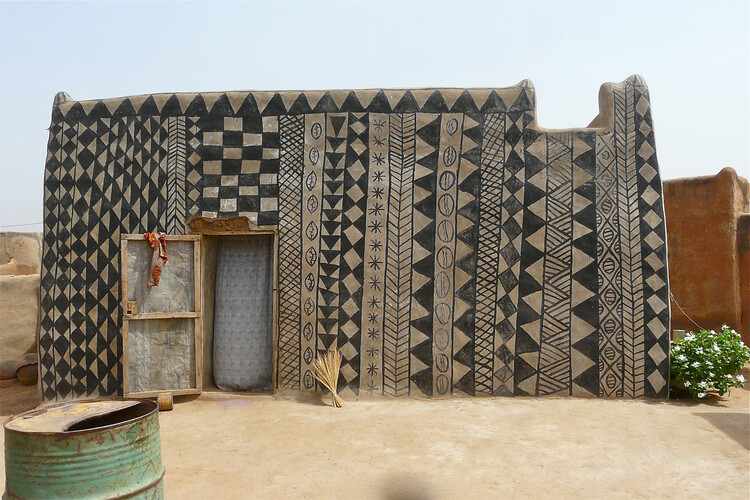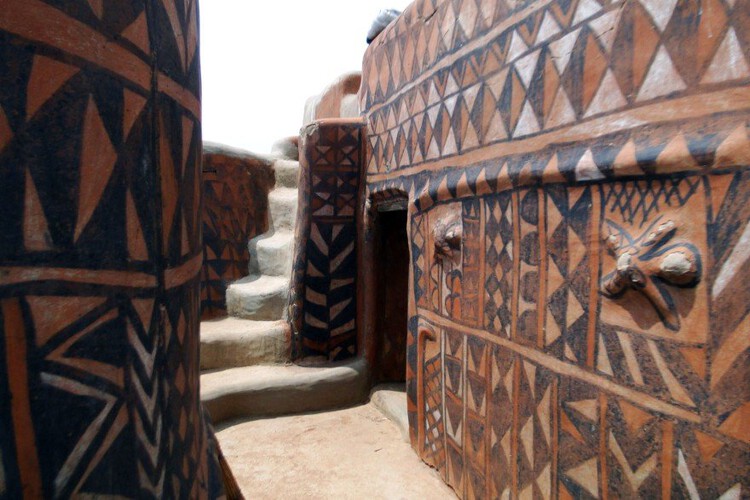
In the south of Burkina Faso, sharing borders with the northern environs of Ghana is Tiébélé; a small village exhibiting fractal patterns of circular and rectangular buildings, housing one of the oldest ethnic groups in West Africa; the Kassena tribe. With vernacular houses dating back to the 15th century, the village’s buildings strike a distinctive character through its symbol-laden painted walls. It is an architecture of wall decoration where the community uses their building envelope as a canvas for geometric shapes and symbols of local folklore, expressing the culture’s history and unique heritage. This architecture is the product of a unique form of communal collaboration, where all men and women in the community are tasked with contributing to the construction and finishing of any new house. This practice serves as a transmission point for Kassena culture across generations.

The decorative craft in Kassena society is rooted in cultural history, reflecting traditional duties, hierarchical positions, and customs. This craft is most evident in the variations among buildings in the royal court, located in the center of the 1.2-hectare village, and other households that expand from the court in a continuous fractal structure as new families emerge. The village is home to 54 native families who trace their history, traditions, and architectural craft back to Loumbila, near Ouagadougou, also in Burkina Faso.
Tiébélé houses are constructed entirely from local materials such as earth, wood, straw, and cow dung. The wall envelopes are constructed to be 30cm thick, creating a favorable interior climate for occupants and serving as a defense mechanism against enemies. These houses are traditionally known as sukhala, and in accordance with Kassena society customs, they are built by men during the dry season (November to March) and decorated by women just before the rainy season. The decorations serve primarily to protect the mud walls from washing away, but have also evolved into an art form using motifs and symbols to convey the customs, religion, and beliefs of the society.
An interesting aspect of the Tiébélé houses is the method of communal construction. When someone's house is going to be decorated, they appeal to all the women in the community to participate in the process, providing them with food and drinks. The oldest woman in the community usually leads the work and defines the decoration patterns, while the other women carry out the tasks with mastery of traditional gestures and unique coordination. The mud wall decorations are actually quite complex. The walls need to be prepared for about a whole day with coatings, then painted with local colors, and finally finished with surface treatments by hand or other tools (such as brooms, pebbles, and feathers) depending on the desired finish. The communal engagement of all women not only makes the process efficient but also creates an opportunity for intergenerational meetings and a point of transmission for Kassena culture. Currently, women in the community are also a unique testimony to centuries-old practices, which allows them to create a plethora of motifs with various meanings.

The decoration techniques for Kassena architecture involve three methods: freehand painting, engravings, and reliefs. Freehand paintings are created by drawing signs directly onto the surface using brushes. Engravings are made by creating incisions on fresh plaster with a roller of a suitable shape. Reliefs are created by projecting patterns out of the earth walls, making them visible. Once the decoration is complete, colors are added. Laterite is used to produce red, Kaolin clay for white, and graphite for black. These colors hold specific meanings for the Kassena people. Red symbolizes courage, white represents honesty and purity, and black symbolizes the night and the invisible world.

As one walks through the labyrinth of houses in Tiébélé, there is a plethora of patterns, from geometric shapes and celestial symbols to animist symbols. Each of them communicates differently about the households within them. For example, stars and moon symbols project hope, arrow symbols on a building indicate the household of a warrior, animist symbols such as crocodiles and snakes are considered sacred and drawn on buildings to keep away bad luck and diseases, while simple geometries like the semi-circle communicate everyday objects like the calabash. Architecture in Tiébélé becomes a canvas for the direct expression of values and aspirations. It goes beyond being just an enclosure that protects from the harsh climate, to a beautiful envelope of communication among different households and as a collective voice within the fractal urban setting.

However, the decorations need to be maintained every three years, which has become a financial burden for locals due to the current prices of materials and the distances they must travel to acquire them. Moreover, due to the topography of the royal court, erosion and flooding pose significant threats to the existence of the mud houses. Despite these challenges, the community respects the decorative traditions and holds an occasional festival of women painters that draws people from around the region. The festival allows for the restoration of buildings in the royal court. There is hope that Tiébélé will eventually be included as a UNESCO Heritage site, which would help sustain the architecture and its traditions.

Tiébélé remains an exceptional testimony of the rich traditions and artistic prowess of the Kassena people as it endures through time. Its artistic decorations have inspired the finishes of new modern buildings in the region and have transcended as templates for fashion, furniture, and products. Its unique form of communal construction and collaborative decoration represents a model in which architectural collaboration can bring everyone together, regardless of status, and can also be a space for sharing other life values.

This feature is part of an ArchDaily series titled AD Narratives where we share the story behind a selected project, diving into its particularities. Every month, we explore new constructions from around the world, highlighting their story and how they came to be. We also talk to the architect, builders, and community seeking to underline their personal experiences. As always, at ArchDaily, we highly appreciate the input of our readers. If you think we should feature a certain project, please submit your suggestions.











